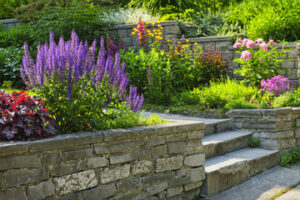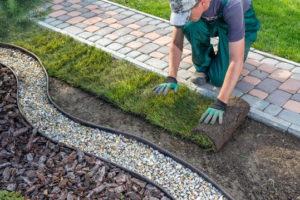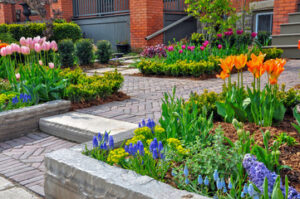Landscaping makes outdoor spaces more pleasant, raises property value and adds functionality. It also helps protect the environment.

Hardscapes are the paved or built components of your landscape like walkways, patios, decks, retaining walls and driveways. They are often made of durable materials. Read on PristineCutsLawnCare for more information.
A well-designed landscape is not only aesthetically pleasing, but it also increases your home value. In fact, some estimates suggest that a quality landscaping adds as much as 15 percent to your home’s worth. That’s why it’s important to plan ahead and budget for your project. Landscaping costs can vary significantly, but understanding what factors influence the price can help you stay within your desired range.
The cost of a landscaping project can vary significantly depending on where you live, but it’s also dependent on the type of design and materials you choose. For example, choosing a high-quality paver over an inexpensive one can make a significant difference in your final costs. Similarly, using native plants will often be cheaper than importing exotic species.
If you’re looking to save money on a large-scale landscape project, consider working with a local company that offers a variety of different services. They can give you a comprehensive quote based on your needs and provide suggestions for ways to cut costs, such as by using existing materials.
It’s also a good idea to consider the long-term costs of your landscaping project when planning your budget. For example, maintenance costs can add up quickly, especially if you’re dealing with a lot of plants. However, the good news is that you can save on these costs by opting for xeriscaping, which is ideal for dry climates and reduces water usage.
Finally, it’s essential to talk with a professional landscaper about your project before you begin. They can offer advice on what to expect and give you an estimate of the total cost, which is typically a percentage of the overall project budget. It’s also a great idea to prioritize the high-impact elements of your landscape, such as a focal point tree or a retaining wall.
Ultimately, the best way to minimize your landscaping costs is to create a detailed plan before you begin. This will help you avoid costly mistakes and ensure a cohesive end result. Additionally, purchasing soil, mulch, and plants in bulk can lower your overall costs.
Design
Landscaping involves the design, planning, and construction of outdoor spaces. It adds aesthetic appeal, increases property value, and makes outdoor living spaces functional. It also helps to preserve natural resources, reduce soil erosion, and increase energy efficiency. Professional landscapers use the principles of proportion, balance, and unity to create a cohesive and inviting outdoor space.
Plants are a crucial part of the landscape, and their placement should be carefully planned. The size of a plant at maturity should be taken into account when planning the layout, and plants should be given enough room to grow and thrive. Also, the colors and textures of different plants should be incorporated to add visual interest.
Hardscaping is another important aspect of the landscape, and it includes features like patios, walkways, retaining walls, and decks. It is vital to plan ahead when installing these elements, as they can be costly and time-consuming. It is also important to consider the placement of these elements, as they should be strategically placed to maximize functionality and aesthetic appeal.
Water features such as ponds and waterfalls are important parts of any landscape, and they can provide a focal point and add beauty. They can also be used to create a sense of movement, and they can help to reduce noise pollution and air temperature. Ornaments such as lanterns, pagodas, and statues can also add visual intrigue and serve as focal points in the garden.
When choosing a lawn or grass, it is important to choose a variety that will thrive in your climate and soil conditions. You should also take into account the amount of sunlight and moisture your yard receives. This will help to determine how much water and maintenance your lawn requires.
It is also important to consider the amount of traffic and activity that will occur in your yard. This will help you decide whether to use low or high-maintenance plants. Low-maintenance plants require less water and fertilizer, and they are easier to maintain than higher-maintenance plants. Low-maintenance lawns are also more affordable than high-maintenance grasses.
Plants
One of the most important aspects of a landscaping job is selecting the right plants to use. This may require some work on the client’s part, such as looking through home and garden magazines or driving around neighborhoods to see what other people have done with their yards. Once a list of the things that the client likes is made, the landscaper can begin to put together a plan.
For a commercial landscaping project, the choice of plants is even more crucial. The plants need to be able to withstand harsh weather conditions and high traffic areas. Perennial plants are a great option for these projects because they are easy to plant and thrive under various elements. They also look good year-round and do not need as much watering as annual flowers.
The landscaper must also consider the type of soil that is present, as well as whether or not there are any drainage problems in the area. A drainage problem can be a serious issue that could lead to flooding, which is why it is important for the landscaping company to address this before the start of any project.
A good landscaping company will also have access to a wide variety of plants and trees. This can help them find the perfect plants for a particular situation, as well as make recommendations on the proper care and maintenance of the plant once it is planted.
The internet is also a great way to advertise a landscaping business. Many landscaping companies have websites with photos of their work and customer reviews, as well as information about the services that they provide. This allows potential customers to get a feel for the company before making a decision to hire them.
Landscaping is a very competitive field, and the right marketing strategy can make the difference between a successful business and one that struggles to survive. The right mix of marketing strategies will vary depending on the individual needs of a landscaping company.
In addition to a website, many landscaping companies have Facebook pages that give potential clients the opportunity to contact them directly with questions or comments. This type of social media marketing is free and provides the opportunity for a direct, personal relationship with prospective customers. Other types of online marketing include search engine optimization (SEO), which involves using specific keywords in order to be found by potential clients on search engines. Landscaping companies can also join networking groups to associate with others in the industry and learn from each other.
Maintenance
Landscaping is a long-term commitment that requires regular maintenance to ensure the health and beauty of your outdoor space. A well-maintained landscape can improve your property’s curb appeal and increase its value.
Landscape contractors are experienced professionals who offer a wide range of services to help you create and maintain your perfect lawn. They can install hardscapes, plant trees and shrubs, and perform regular lawn care tasks such as mowing and trimming. Landscaping contractors can also add visual interest to your yard with features such as water gardens and rock gardens. They can also create outdoor living spaces such as patios, fire pits, and garden sheds.
A well-designed landscape can transform a dull outdoor space into a relaxing, comfortable area that enhances your home’s value and appeal. Landscaping professionals can also make your home more energy-efficient by installing solar-powered lights and water features. Landscaping can also promote healthy lifestyles by encouraging physical activity through the use of trails and outdoor exercise equipment.
In order to keep your yard in top shape, you need to perform regular landscaping tasks such as mowing, fertilizing, and pruning. Regular maintenance also includes mulching to retain moisture, improve soil quality, and suppress weed growth. In addition to these basic landscaping tasks, you should consider the climate of your region and its effect on your garden’s plants and trees. For example, dry weather may necessitate watering your plants more frequently, while cool temperatures could reduce their growth rate.
A key difference between landscaping and gardening is that landscaping focuses on the creation of large-scale design elements, such as outdoor structures and garden beds. In contrast, gardening focuses on the care and cultivation of individual plants. Knowing when your project shifts from landscaping to construction is important because constructing new structures and making significant changes to the terrain generally requires permits and adherence to local building codes, which simple maintenance tasks do not. In addition, construction projects typically require skilled labor and often require specialized equipment.

